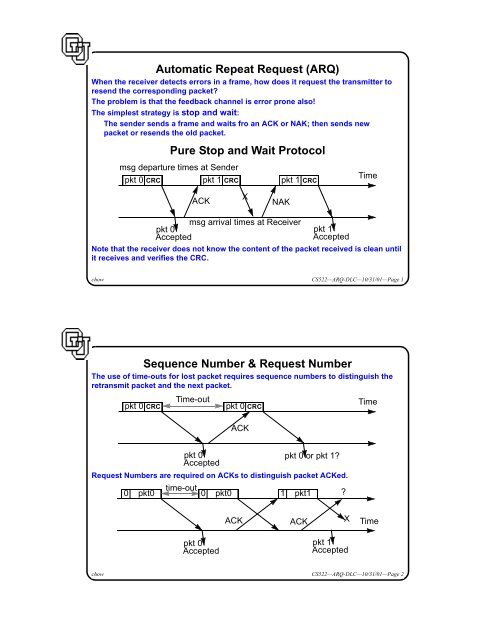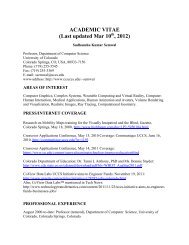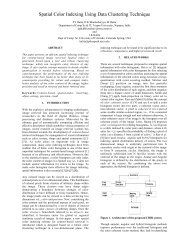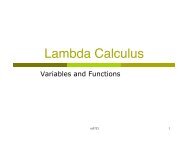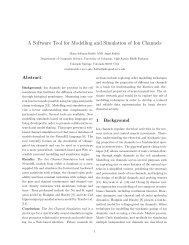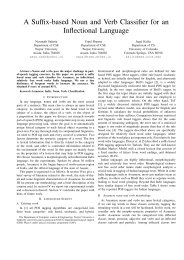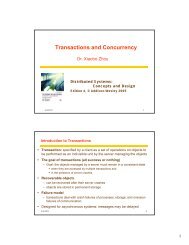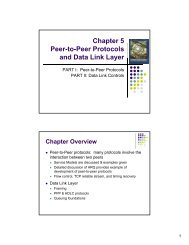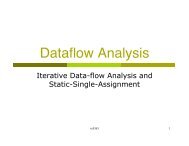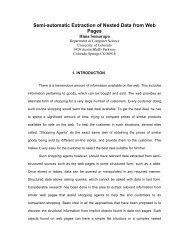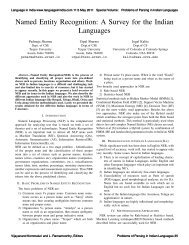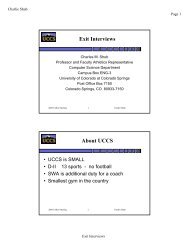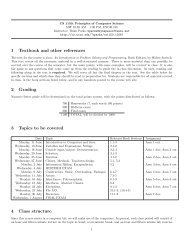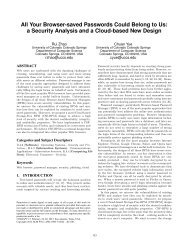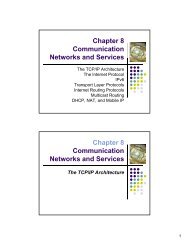Automatic Repeat Request (ARQ) Pure Stop and Wait ... - UCCS
Automatic Repeat Request (ARQ) Pure Stop and Wait ... - UCCS
Automatic Repeat Request (ARQ) Pure Stop and Wait ... - UCCS
You also want an ePaper? Increase the reach of your titles
YUMPU automatically turns print PDFs into web optimized ePapers that Google loves.
<strong>Automatic</strong> <strong>Repeat</strong> <strong>Request</strong> (<strong>ARQ</strong>)<br />
When the receiver detects errors in a frame, how does it request the transmitter to<br />
resend the corresponding packet?<br />
The problem is that the feedback channel is error prone also!<br />
The simplest strategy is stop <strong>and</strong> wait:<br />
The sender sends a frame <strong>and</strong> waits fro an ACK or NAK; then sends new<br />
packet or resends the old packet.<br />
<strong>Pure</strong> <strong>Stop</strong> <strong>and</strong> <strong>Wait</strong> Protocol<br />
msg departure times at Sender<br />
pkt 0 CRC pkt 1 CRC<br />
X<br />
ACK NAK<br />
pkt 1 CRC<br />
Time<br />
msg arrival times at Receiver<br />
pkt 0<br />
pkt 1<br />
Accepted<br />
Accepted<br />
Note that the receiver does not know the content of the packet received is clean until<br />
it receives <strong>and</strong> verifies the CRC.<br />
chow CS522—<strong>ARQ</strong>-DLC—10/31/01—Page 1<br />
Sequence Number & <strong>Request</strong> Number<br />
The use of time-outs for lost packet requires sequence numbers to distinguish the<br />
retransmit packet <strong>and</strong> the next packet.<br />
pkt 0 CRC<br />
<strong>Request</strong> Numbers are required on ACKs to distinguish packet ACKed.<br />
0 pkt0<br />
Time-out<br />
pkt 0<br />
Accepted<br />
pkt 0 CRC<br />
ACK<br />
time-out 0 pkt0 1 pkt1<br />
pkt 0<br />
Accepted<br />
ACK<br />
pkt 0 or pkt 1?<br />
ACK<br />
Time<br />
Time<br />
chow CS522—<strong>ARQ</strong>-DLC—10/31/01—Page 2<br />
?<br />
X<br />
pkt 1<br />
Accepted
<strong>Request</strong> Number<br />
Instead of sending ACK or NAK, the receiver sends the number of the packet currently<br />
awaited.<br />
Sequence numbers <strong>and</strong> request numbers can be sent module 2. What is the name of<br />
this protocol?<br />
This works correctly for all combinations of delay <strong>and</strong> time-outs assuming that<br />
1) Frames travel in order (FCFS) on links<br />
2) The CRC never fails to detect errors<br />
3) The system is correctly initialized.<br />
SN 0<br />
Sender<br />
Receiver<br />
RN<br />
pkt<br />
Accepted 0<br />
1<br />
1<br />
0<br />
1<br />
1 2<br />
Time<br />
chow CS522—<strong>ARQ</strong>-DLC—10/31/01—Page 3<br />
Go Back n <strong>ARQ</strong> & Selective <strong>Repeat</strong> <strong>ARQ</strong><br />
Desirable to send data while awaiting an ack.<br />
The usual approach for this is called go back n <strong>ARQ</strong>.<br />
Two alternate approaches:<br />
1) Selective repeat <strong>ARQ</strong><br />
2) ARPANET (Multiplex stop <strong>and</strong> wait schemes)<br />
Goback n (Sliding Window) <strong>ARQ</strong><br />
St<strong>and</strong>ard scheme used by HDLC, SDLC, ADCCP, X25.<br />
Packets are numbered in order of arrival (SN); SN is sent in frame header (as in stop<br />
<strong>and</strong> wait).<br />
Receiver sends “request number” RN back to transmitter; says that receiver wants<br />
packet RN next (i.e., RN is the awaited number). RN is usually “piggybacked” on<br />
return traffic.<br />
Frame Header<br />
chow CS522—<strong>ARQ</strong>-DLC—10/31/01—Page 4<br />
2<br />
SN RN Packet CRC<br />
2<br />
3<br />
3<br />
3
Goback n (Sliding Window) <strong>ARQ</strong><br />
The transmitter has a “window” of n packets that can be sent without acknowledgments.<br />
This window ranges from the last value of RN obtained from the receiver (denoted<br />
SNmin ) to SNmin +n–1.<br />
When the transmitter reaches the end of its window, or times out, it goes back <strong>and</strong><br />
retransmits packets starting from SNmin .<br />
Example of Goback 7 <strong>ARQ</strong><br />
Window (0,6) (1,7) (2,8) (3,9) (5,11)<br />
SN<br />
Node A<br />
0 1 2 3 4 5 6<br />
Node B<br />
RN<br />
0<br />
0 1 2<br />
3 5 5<br />
Time<br />
pkt<br />
Accepted 0 1 2 3 4 5<br />
Note that packet RN–1 must be accepted at Node B before a frame containing request<br />
RN can start transmission at Node B.<br />
chow CS522—<strong>ARQ</strong>-DLC—10/31/01—Page 5<br />
Retransmission Due to Errors for Goback 4 <strong>ARQ</strong><br />
Window (0,3) (1,4) (2,8)<br />
SN<br />
Node A<br />
Node B<br />
0 1 2<br />
X<br />
3 4 1 2 3 4<br />
RN 0 1 1 1 1 1 2 3<br />
pkt<br />
Accepted<br />
0<br />
2 3<br />
Time<br />
chow CS522—<strong>ARQ</strong>-DLC—10/31/01—Page 6<br />
1<br />
4
Module m in Goback n systems<br />
SN <strong>and</strong> RN are actually sent module m in Goback n systems.<br />
The constraint is that n < m.<br />
The st<strong>and</strong>ard choice is m=8; three bits for SN, three bits for RN.<br />
Optional st<strong>and</strong>ard is m=128 (for satellite channels <strong>and</strong> other channels where round<br />
trip delay is large relative to packet transmission time).<br />
Goback n is guaranteed to work correctly if<br />
1) System is correctly initialized.<br />
2) No failures in detecting errors.<br />
3) Frame travel in FCFS order.<br />
4) Positive probability of correct reception.<br />
5) Transmitter occasionally resends SNmin<br />
6) Receiver occasionally sends RN.<br />
chow CS522—<strong>ARQ</strong>-DLC—10/31/01—Page 7<br />
Go Back n < 2 m<br />
where m is the # of bits used in sequence # field.<br />
If we use n = 2m, we will accept retransmitted frames.<br />
chow CS522—<strong>ARQ</strong>-DLC—10/31/01—Page 8
For the following go-back-3 protocol execution, what ack msg should be sent<br />
back?<br />
chow CS522—<strong>ARQ</strong>-DLC—10/31/01—Page 9<br />
Goback N with NAK<br />
chow CS522—<strong>ARQ</strong>-DLC—10/31/01—Page 10
Selective <strong>Repeat</strong> <strong>ARQ</strong><br />
need more buffer on receiver<br />
can receive pkts out of order<br />
chow CS522—<strong>ARQ</strong>-DLC—10/31/01—Page 11<br />
Select <strong>Repeat</strong> <strong>ARQ</strong><br />
Efficiency of Goback n can be increased by accepting packets out of order.<br />
An explicit NAK (selective reject) can request retransmission of just one packet.<br />
Typical frame error rates are less than 0.001; selective repeat does not gain much in<br />
efficiency unless there are very many frames in a round trip delay.<br />
For a window size of n, the modulus must be at least 2n. or For m bit sequence #, us<br />
window size of 2 m-1 .<br />
chow CS522—<strong>ARQ</strong>-DLC—10/31/01—Page 12
2 m-1 window size for Selective <strong>Repeat</strong> <strong>ARQ</strong><br />
retransmission<br />
Use a window size<br />
similar to Goback n<br />
n=2 m Incorrect Way<br />
-1<br />
it falls in receive window <strong>and</strong> will<br />
be accepted as a new msg.<br />
Correct Window size to use 2 m-1<br />
Its sequence # not within receive window<br />
It is recognized as duplicate msg.<br />
chow CS522—<strong>ARQ</strong>-DLC—10/31/01—Page 13<br />
Efficiency vs. Error Rate<br />
chow CS522—<strong>ARQ</strong>-DLC—10/31/01—Page 14
Efficiency vs. Optimal Frame Size<br />
chow CS522—<strong>ARQ</strong>-DLC—10/31/01—Page 15<br />
Frame Synchronization<br />
Three approaches to find frame <strong>and</strong> idle fill boundaries:<br />
1) Character-oriented protocols<br />
2) Bit-oriented protocol (use flags)<br />
3) Length counts (characters or bits).<br />
1. Character-oriented Protocols:<br />
In IBM BSC (Binary Synchronous Comm.), a frame begins at the end of a<br />
sequence of two or more SYN characters in the incoming signal.<br />
Normal Mode:<br />
SYN SYN [control <strong>and</strong> data characters] BCC BCC<br />
8 8<br />
terminated by ITB, ETB, or ETX character<br />
SYN SYN [Control characters]<br />
Note: 1. SYN is a ASCII character with 00010110 pattern.<br />
2. BCC BCC are 16 parity bits for error detection.<br />
Transparent Text Mode:<br />
SYN SYN DLE STX [transparent data] DLE ETX BCC BCC<br />
The transparent data may contain DLE control character → character stuffing.<br />
chow CS522—<strong>ARQ</strong>-DLC—10/31/01—Page 16
Sender<br />
Character Stuffing<br />
DLE STX A DLE B DLE ETX<br />
Data Link Layer:Character-oriented Protocol at transparent text mode<br />
Drawbacks of character-oriented framing:<br />
Character code dependent<br />
Errors in control characters are difficult to h<strong>and</strong>le.<br />
Data from Network Layer<br />
SYN SYN DLE STX<br />
*<br />
DLE DLE STX A<br />
*<br />
DLE DLE B<br />
*<br />
DLE DLE ETX DLE ETX BCC BCC<br />
Stuffed transparent data<br />
*:stuffed DLE<br />
Frame comes down from data link layer<br />
Physical Layer<br />
Receiver<br />
Data Link Layer:Character-oriented Protocol at transparent text mode<br />
DLE STX A DLE B DLE ETX Data to Network Layer<br />
chow CS522—<strong>ARQ</strong>-DLC—10/31/01—Page 17<br />
Exercise on Character Stuffing<br />
Using BSC protocol operating at text transparent mode, given the data DLE, DLE, A,<br />
DLE from the network layer, what will be the frame sent out?<br />
Ans: The frame sent out is as follows (in transparent text mode):<br />
SYN SYN DLE STX<br />
*<br />
DLE<br />
*<br />
DLE DLE DLE A<br />
*<br />
DLE DLE DLE ETX BCC BCC<br />
*:stuffed DLE<br />
chow CS522—<strong>ARQ</strong>-DLC—10/31/01—Page 18
Bit-oriented Protocol<br />
HDLC, SDLC, ADCCP are bit-oriented protocols.<br />
All frames look like<br />
F address control info FCS F<br />
Flag F is the unique sequence 01111110<br />
variable length transparent data<br />
Bits subject to<br />
1. error checking<br />
2. insertion/deletion of a zero following 5 consecutive ones<br />
chow CS522—<strong>ARQ</strong>-DLC—10/31/01—Page 19<br />
Bit Stuffing<br />
A 0 is stuffed after each consecutive five 1’s in the original frame.<br />
A flag, 01111110, without stuffing, is sent at the end of the frame.<br />
Destuffing<br />
If 0 is preceded by 011111 in received bit stream, remove it.<br />
If 0 is preceded by 0111111, it is the final bit of the flag.<br />
Example: Bits to be removed are underlined below<br />
1001111101100011110111110001111110<br />
Flag<br />
Why is it necessary to stuff a 0 in 0111110? If not, then<br />
0111110111→ 0111110111<br />
011111111→ 0111110111<br />
The overhead per frame in the flag scheme is one byte for the flag plus 1/64 times the<br />
expected frame length.<br />
For short frame lengths, this is essentially optimally efficient.<br />
chow CS522—<strong>ARQ</strong>-DLC—10/31/01—Page 20
Length Counts Framing<br />
Some DLC protocols use a header field to give the length of the frame (in bits, or<br />
bytes). This conveys the same information as the flag scheme <strong>and</strong> uses essentially<br />
the same overhead.<br />
Example: DECNET uses length counts approach.<br />
A disadvantage is that resynchronization is needed after an error in the length count.<br />
Framing Errors<br />
An error in a flag, or a flag created by an error causes a frame to disappear or an extra<br />
frame to appear.<br />
An error in a length count field causes the frame to be terminated at the wrong point<br />
(<strong>and</strong> makes it tricky to find the beginning of the next frame.<br />
An error in DLE, STX, or ETX causes the same problems.<br />
When a framing error is made, the receiver looks in the wrong place for CRC. With a<br />
16 bit CRC, the probability of false acceptance is about 2 -16 .<br />
DECNET partially avoid the problem by putting CRC on packet header; inefficient.<br />
Using a longer CRC is probably the best current solution to this problem.<br />
chow CS522—<strong>ARQ</strong>-DLC—10/31/01—Page 21<br />
DLC St<strong>and</strong>ards<br />
HDLC, ADCCP, LAPB (X.25 layer 2), <strong>and</strong> SDLC are almost the same except that LAPB<br />
<strong>and</strong> SDLC are subsets of HDLC <strong>and</strong> ADCCP (which are virtually identical).<br />
These classes of protocols all use flags for flaming <strong>and</strong> goback n for error detection<br />
<strong>and</strong> retransmission.<br />
8 8 8 16 8<br />
Flag Address Control Packet CRC Flag<br />
The address field allow use on multipoint lines.<br />
Polling/Final Bit<br />
0 SN P/F RN<br />
1 0 Type P/F RN<br />
1 1 Type P/F Type<br />
Control Byte Format<br />
Information frames use SN <strong>and</strong> RN for goback n (mod 8)<br />
Supervisory frames send ACKs (RN) without data<br />
Unnumbered frames are for initiation, termination, etc.<br />
Information<br />
Supervisory<br />
Unnumbered<br />
chow CS522—<strong>ARQ</strong>-DLC—10/31/01—Page 22
Control Frames<br />
There are four types of supervisory frames that send ack information.<br />
receive ready (normal ACK)<br />
receive not ready (ACks but requests no further data)<br />
reject (to explicitly send a NAK)<br />
selective reject (for primitive selective repeat)<br />
The unnumbered frames are used to initiate <strong>and</strong> terminate the link protocol <strong>and</strong> to<br />
send various special comm<strong>and</strong>s.<br />
There are 3 modes of operations - asynchronous balanced (LAPB), normal response<br />
(SDLC), <strong>and</strong> asynchronous response (SDLC). The third is rarely used, the second is<br />
for master/slave relationships (<strong>and</strong> not at all normal), <strong>and</strong> the first is normal for data<br />
networks.<br />
The unnumbered frames initiate operation in one of these modes. The error h<strong>and</strong>ling<br />
on these unnumbered frames is somewhat defective.<br />
chow CS522—<strong>ARQ</strong>-DLC—10/31/01—Page 23<br />
Point-to-point data link protocol for Internet<br />
1. SLIP<br />
SLIP⎯Serial Line IP (RFC1055)<br />
designed by Rick in 1984 to connect Sun workstations over dial up line.<br />
send raw IP packet with a flag byte (0xC0) at the end for framing.<br />
if flag byte pattern occurs in raw IP packet, send 0xDB, 0xDC instead (what<br />
kind of stuffing is this?)<br />
perform TCP/IP header compression (RFC1144)<br />
⎯omit duplicated header fields,<br />
⎯send incremental value for fields with different values.<br />
Problems:<br />
⎯no error detection or correction. (up to the higher layer)<br />
⎯only support IP.<br />
⎯must know other’s IP in advance, can’t do dynamic IP address assignment<br />
⎯no authentication (for leased line it is ok, for dial up line it is not).<br />
⎯not an approved Internet st<strong>and</strong>ard.<br />
chow CS522—<strong>ARQ</strong>-DLC—10/31/01—Page 24
Point-to-point data link protocol for Internet: PPP<br />
PPP⎯Point-to-Point Protocol (RFC1661, 1662, 1663)<br />
designed by IETF group.<br />
provide error detection (check sum at the end of frame)<br />
Use HDLC frame structure with character stuffing.<br />
⎯address field always 11111111 (all stations to accept the frame).<br />
⎯control field 00000011, unnumbered frame (RFC1663 extend to numbered<br />
frame, for reliable transmission, such as wireless.)<br />
⎯a new protocol field to indicate packet type (LCP, NCP, IP, IPX, AppleTalk)<br />
default payload length is 1500 bytes.<br />
use LCP (Link Control Protocol) to bring line up, test them, negotiate options<br />
(such as omit address <strong>and</strong> control fields, one or two byte in protocol field) <strong>and</strong><br />
bring them down gracefully.<br />
support multiple protocols<br />
used with dial-up lines, SONET, bit-oriented HDLC lines.<br />
use Network Control Protocol (NCP) to negotiate IP addresses.<br />
permit authentication<br />
a clear choice for future dial-up lines <strong>and</strong> leased router-router lines.<br />
chow CS522—<strong>ARQ</strong>-DLC—10/31/01—Page 25<br />
PPP Phase Diagram<br />
chow CS522—<strong>ARQ</strong>-DLC—10/31/01—Page 26


